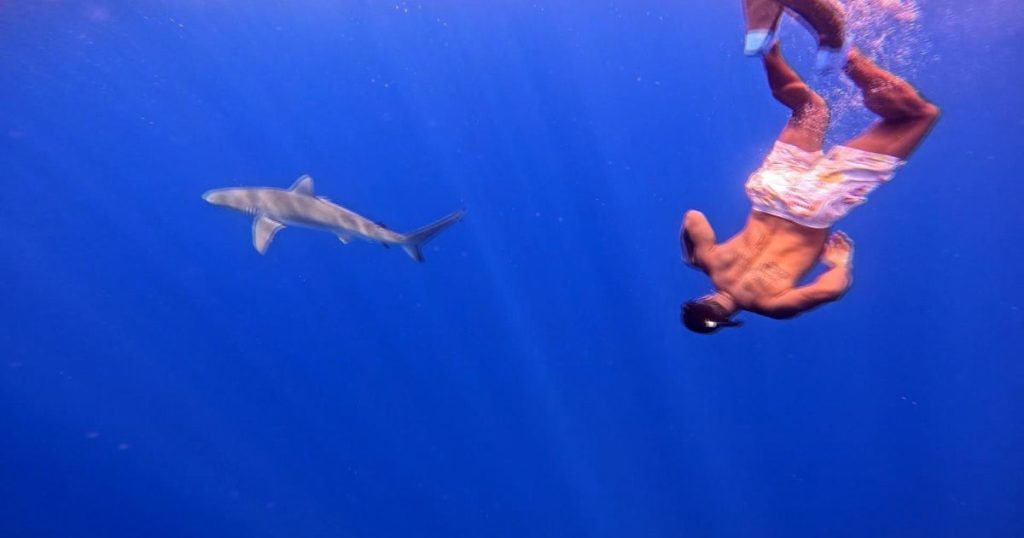Recently, TV personality Nate Burleson faced his lifelong fear of sharks by swimming among Galapagos sharks off the coast of Oahu’s North Shore. This daring adventure was part of the “Never Too Late” series on “CBS Mornings,” aimed at inspiring viewers to confront their fears. Burleson’s experience highlights a shift in understanding of these often-misunderstood ocean predators.
| Article Subheadings |
|---|
| 1) The Adventure Begins |
| 2) Sharks: The Misunderstood Predator |
| 3) Fear Confronted: A Mother’s Worry |
| 4) Personal Transformation |
| 5) The Impact of Media on Perceptions |
The Adventure Begins
Off the scenic coastline of Oahu’s North Shore, the crystal-clear Pacific waters serve as the backdrop for a thrilling encounter with nature’s fiercest predators—the Galapagos sharks. On this occasion, Nate Burleson, co-host of “CBS Mornings,” decided to embrace this risk by swimming among these majestic creatures without the protection of a cage. This event was part of a series designed to encourage individuals to face their fears and step outside their comfort zones.
Burleson’s participation in this adventure was not without precedent; he had previously challenged himself by skydiving in tandem with the U.S. Army. This latest endeavor merged excitement with apprehension, as Burleson had harbored a fear of sharks for years. Furthermore, this experience aimed not only to entertain but to inspire others to confront their own fears and overcome them.
Sharks: The Misunderstood Predator
Galapagos sharks, with their sleek bodies and powerful fins, can grow to more than 10 feet long and possess 14 rows of serrated teeth. Despite their intimidating appearance, experts argue that humanity’s understanding of sharks has long been skewed by numerous misconceptions. Dr. Andrew Rossiter, director of the Waikiki Aquarium in Honolulu, emphasizes that while sharks are apex predators in the ocean, humans are not their natural prey.
Rossiter shares his extensive experience diving with sharks, having observed “hundreds and hundreds” of them during his career. For him, it is a journey of awe rather than fear. “The more I see them, the more respect I have for them,” he reflects. His insights offer a refreshing perspective on creatures who have been demonized in popular culture.
Fear Confronted: A Mother’s Worry
While Burleson was excited about his venture, his decision was met with skepticism from his family, particularly his mother. When he called to share his plans, she voiced her grave concerns. “Oh, I don’t feel good about that at all,” she remarked, expressing a mother’s natural instinct to protect her child from danger. “I don’t trust you. I don’t trust the sharks, and I don’t trust the water! Period!”
The tension between parental worry and personal ambition is a relatable theme, one that underscores the emotional aspect of confronting fears. Despite his mother’s apprehensions, Burleson found solace in the water, describing a sense of comfort around the sharks that surpassed his initial expectations.
Personal Transformation
Once submerged in the ocean, Burleson’s experience transformed dramatically. He later shared, “I felt comfortable around them… the way they circle around, and like peep you out,” capturing the essence of his newfound relationship with these oceanic creatures. He even likened the experience to a friendly greeting, noting, “If you look at them and you’re like, ‘What’s up fam?’ They will just cruise on by.” This statement encapsulates a shift in his perspective from fear to appreciation.
After emerging from the water, Burleson reflected on the newfound respect he had developed for the sharks. His words reveal a deeper understanding of nature and whether perceived threats can be embraced and respected, rather than feared.
The Impact of Media on Perceptions
The evolution of Burleson’s perception of sharks is largely influenced by cultural depictions of these animals, particularly the blockbuster film “Jaws,” released in 1975. This movie altered public opinion, instilling a pervasive fear of sharks that has persisted for decades. As society continues to engage with media, the portrayal of sharks often skews public opinion, emphasizing danger over education and understanding.
Burleson’s transformative experience underscores the potential for media to inspire change. By showcasing his positive encounter with sharks, he encourages viewers to reconsider their assumptions about these creatures. This kind of public storytelling can play a crucial role in reshaping perceptions of nature and fostering a healthier relationship between humans and our oceanic environments.
| No. | Key Points |
|---|---|
| 1 | Nate Burleson swam among Galapagos sharks to confront his fear. |
| 2 | Experts suggest that sharks are often misunderstood and humans are not their natural prey. |
| 3 | Burleson’s mother expressed concern over his shark diving adventure. |
| 4 | The experience led to a personal transformation and improved perspective on sharks. |
| 5 | Media representations, such as “Jaws,” have shaped public perceptions of sharks. |
Summary
Nate Burleson’s recent encounter with Galapagos sharks in Oahu serves as a powerful reminder of the importance of confronting fears head-on. The shift in his perception—from fear to respect—highlights not only the often-misunderstood nature of sharks but also the transformative power of facing one’s fears. As media’s role in shaping public opinion continues, Burleson’s experience encourages a reevaluation of how we view these majestic creatures.
Frequently Asked Questions
Question: What kind of sharks did Nate Burleson swim with?
Nate Burleson swam with Galapagos sharks, a species known for their sleek bodies and size.
Question: What prompted Burleson’s shark dive?
Burleson participated in the shark dive as part of the “Never Too Late” series on “CBS Mornings,” aimed at encouraging individuals to confront their fears.
Question: How did Burleson’s mother react to his shark diving plans?
Burleson’s mother expressed significant concern about his decision, fearing for his safety around sharks and the ocean.


